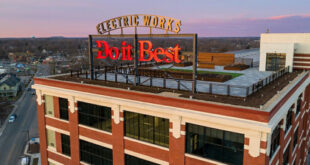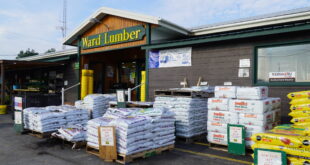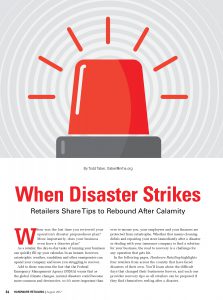
Click the picture to download a PDF of this story.
When Disaster Strikes
When was the last time you reviewed your operation’s disaster preparedness plan? More importantly, does your business even have a disaster plan?
As a retailer, the day-to-day tasks of running your business can quickly fill up your calendar. In an instant, however, catastrophic weather, vandalism and other emergencies can upend your company and leave you struggling to recover.
Add to these concerns the fact that the Federal Emergency Management Agency (FEMA) warns that as the global climate changes, natural disasters could become more common and destructive, so it’s more important than ever to ensure you, your employees and your finances are protected from catastrophe. Whether that means cleaning debris and repairing your store immediately after a disaster or dealing with your insurance company to find a solution for your business, the road to recovery is a challenge for any operation that gets hit.
In the following pages, Hardware Retailing highlights four retailers from across the country that have faced disasters of their own. You’ll learn about the difficult days that changed their businesses forever, and each one provides recovery tips so all retailers can be prepared if they find themselves reeling after a disaster.
Emergency Checklist
Consider these tips as your business establishes its disaster preparedness plan. For more information on safeguarding your operation and to download this checklist, click here.
Back Up Your Data
Physical data backups in a second location can keep important documents safe from severe weather. Also, research cloud data storage options; they’re inexpensive and easy to manage.
Take Photos
Taking photos of damage your store withstands can streamline your insurance claims and be a powerful way to keep your community updated via social media.
Stay Informed
Monitor severe weather in your area and keep tabs on any protests that could imperil your operation. Consider letting employees leave early to get home safely.
Store Supplies
Have bottled water, nonperishable food, first-aid kits and a weather radio close at hand to keep you and your employees safe and with access to the latest news.
Review Your Insurance
Annual insurance audits are critical. Research replacement cost coverage, business interruption coverage and employee compensation to keep your finances in order following a disaster.
Identify a Shelter
Clearly mark disaster shelter areas. Make sure all employees know their location and are able to guide customers there if necessary.
Be Flexible
Scout temporary locations to sell undamaged items and invest in mobile credit card readers to keep sales steady and retain your customer base after an emergency.
Keep in Touch
Whether you’re informing your suppliers or telling customers about temporary locations, social media updates can engage customers and stimulate sales after an emergency.

2015 with the help of store employees and devoted community members.
Flash Flood
Wilson Carter Supply Co.
Denton, North Carolina
Anne Carter Bean, manager of Wilson Carter Supply Co., has seen firsthand how flash floods can quickly devastate small businesses.
A few days after Christmas 2015, she and her employees struggled to clear rapidly rising water from the store her family has owned since 1965. They were soon overwhelmed as 16 inches of water swept through the store, covering lower electric outlets, waterlogging inventory left on lower shelves and warping ledgers her family had kept throughout the store’s history.
As the floodwaters receded, Bean was overwhelmed by the damage and the amount of work her store faced in the storm’s aftermath. Half an inch of water remained, bringing with it a coating of mud, silt and debris. The flood had displaced inventory and seeped through wall paneling, which would need to be removed to prevent mold. Despite the wreckage, Bean and her team set to work to restore the business.
Contact the Community
“It was yucky and rainy, and when the rain kept coming down, I just started snapping photos,” Bean says.
She posted pictures to Facebook as soon as the store began to flood. Continuing to make social media updates turned out to be a vital part of keeping her customers informed about the store’s status and inspired volunteers to visit and help with the cleanup. Customers kept shopping because they knew the business was still open, and volunteers knew the staff needed fans, generators and manpower to run the store and salvage any inventory they could.
Photos like the ones Bean uploaded are also useful for insurance claims and provide a way for your community to connect with ongoing cleanup efforts.
Bean planned to close the store temporarily, but didn’t have to. Steady support from volunteers allowed the staff to keep the business operational, and customers who were looking for items to aid their own flood recovery continued to spend money at the store.
“We actually had customers that came in to buy stuff even as we were cleaning up,” she says. “We had about 60 people who came to help in some way, shape or form, and it just blew my mind.”
Bean decided to display sales bins of heavily discounted items that had slight flood damage, but were still usable. The bins included an assortment of paint sundries, safety gloves and electrical items that didn’t include internal wiring.
“We got something out of them instead of just tossing them in the dumpster,” she says.
Inform Your Suppliers
Bean recommends that other retailers contact their suppliers immediately after a disaster strikes.
“I sent out a letter to all of my suppliers letting them know what had happened,” she says. “They were extremely supportive in terms of giving us a little more leeway than we normally would have.”
Bean says it was about three months before her family’s hardware store truly felt back to business as usual, and she credits her community’s response for helping the store bounce back.
“For me, making people aware of the situation went further than I ever could have imagined,” she says.

Tornado
Sagona’s Hardware
Paincourtville, Louisiana
David Sagona, owner of Sagona’s Hardware, remembers the exact moment a tornado destroyed his hardware store in 2016.
“3:24 p.m. That’s when all hell broke loose,” Sagona says.
Shortly after, 140-mph winds from a 300-yard-wide tornado demolished his employees’ cars, peeled off the store’s metal roof and toppled its front wall. Tree limbs crashed through his store, and inventory became dangerous projectiles as he and his employees scrambled for safety.
“They say you hear a freight train, but I heard 10 freight trains that day,” he says. When the tornado passed, Sagona and his employees emerged to a hardware store in ruins.
Put Safety First
Sagona recommends that all business owners designate an emergency weather shelter before a disaster. He led his employees to an interior office on the building’s first floor, but wishes he had made employees aware of severe weather protocol before it was necessary.
His local weather forecasters suggested severe weather was a possibility that day, but Sagona says he didn’t take the forecast seriously because tornadoes aren’t common in Louisiana. In hindsight, he says he should have considered letting employees leave early, but feels lucky that no one at his store was injured.
Take Your Policy to a Pro
Sagona’s insurance covered most of his property and merchandise loss, which amounted to roughly $1 million, but he recommends carefully evaluating your policies and even having a lawyer or trusted advisor review your policy before you sign.
“With owning a business, I was getting pulled in a million different directions,” he says. “I took the insurance for granted.”
Specifically, Sagona recommends making sure your business has replacement cost coverage as opposed to actual cash value protection. Replacement cost insurance calculates what your damaged items would cost to replace at current prices, whereas actual cash value insurance pays business owners the cost of what they paid for specific items, minus their depreciated value, which often results in a lower payout.
His business insurance only covered certain employees’ wages and only for a 90-day period, which forced Sagona to lay off all his employees as he began the long road to rebuilding the store. He hopes to rehire some of his 15 former employees when he reopens later this fall.
Seize Opportunities
Before the tornado, Sagona’s Hardware also sold firearms and held concealed carry classes behind the store. In the months since the tornado, Sagona has leased an abandoned grocery store and decided to temporarily focus on selling firearms to keep sales flowing as he restocks hardware inventory. This fall, he and his team hope to reintroduce a full selection of hardware supplies and firearms and lease their new location to save money.
As he restocks his hardware inventory, sales are “nowhere near” where they were before the tornado, but he’s making the most of his new space. He’s taking the opportunity to design a hardware store from the ground up and will be able to stock items he didn’t have room for at his former location.
“I bought this store from somebody, so now I can design it how I want to see it,” Sagona says.
He says that he thought about closing the store for good after the tornado, but is forging ahead.
“I’m still young enough to get the business back up and rolling again,” Sagona says.
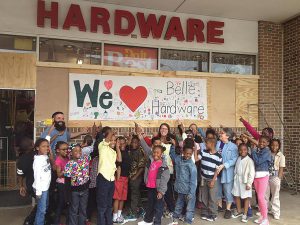
Rioters
Belle Hardware
Baltimore
Mickey Fried says that for a moment, the historic Bolton Hill neighborhood of Baltimore, where his family has owned Belle Hardware since 1978, was filled with “raw emotion.”
In April 2015, protestors took to the streets after Baltimore resident Freddie Gray fell into a coma while in police custody and later died. Rioters took advantage of a volatile situation, ransacking more than 280 businesses and causing an estimated $9 million in property damage, according to The Baltimore Sun.
Take Every Precaution
Following a weekend of mounting tension, police encouraged business owners to close their stores early in the afternoon on April 27. Fried was out of state, so it fell to his mother, co-owner Janice McCulley, to heed the police’s warnings, lock the shop, activate security alarms and keep tabs on its condition as best she could.
After a security alarm sounded later that night, McCulley returned with friends and neighbors in a final effort to safeguard the store, boarding up the glass windows rioters had already broken. Soon, she left Belle Hardware as more looters prowled the shopping center.
Survey the Damage
Fried sped back to Baltimore early the next morning, fearing the worst, but was surprised by what he discovered.
“I came in, expecting to pick up glass and debris all day, but it was already done. There was a volunteer army cleaning up our shop,” he says. Local residents and shopkeepers were helping one another recover, doing what they could to reverse the violence of the previous night. This allowed his staff to focus on providing supplies to assist in other local cleanup efforts. They did sell items during the recovery, but also donated materials to help their neighborhood bounce back.
“We’ve got shovels, we’ve got brooms, let’s just get stuff in people’s hands and we’ll figure it all out later,” Fried says. He says there was some debate over whether to charge for these items, but “the only way you can worry about next month is by being open next month.”
As he inspected the store, Fried noted the damage to the property was costlier than the items taken. Looters stole a few pieces of high-priced power equipment as well as inexpensive items like cigarette lighters and mousetraps, but had bored a hole through an adjacent laundromat to access his store and broken every window throughout the night.
Take Charge of Minor Repairs
In the following days, insurance companies were overwhelmed by claims, and glass companies were reluctant to replace windows, fearing other riots might flare up and destroy their work. Fried recommends store owners remain patient and take charge of any minor repairs they may need.
Students from a nearby school volunteered to decorate the plywood that temporarily covered Belle Hardware’s windows, a small act that helped unite volunteers and business owners.
“Except for the glass, I didn’t have to rely on anyone to come out and service anything. I did a lot of the repairs myself,” Fried says.
Sales were sluggish in the days following the riots, as Baltimore residents were hesitant to venture out of their homes, but returned to normal levels within three months, he says.
Fried is proud his hardware store was able to recover quickly and provide supplies to other merchants for their cleanup efforts. He recommends hardware retailers not lose sight of what truly matters following a catastrophe.
“There’s nothing in this building that’s worth the life of my employees or anyone I know,” Fried says.
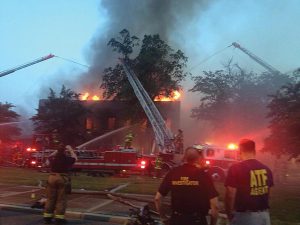
Fire
Frager’s Hardware
Washington, D.C.
Nick Kaplanis, general manager and 20-year employee of Frager’s Hardware, calls Washington, D.C., “a big city, but a small community.”
When a four-alarm fire engulfed the store in June 2013, Kaplanis and his team vowed not to let the hardware store, which had served the Capitol Hill area since 1920, close on their watch.
Make Every Minute Count
Immediately following the fire, the staff scouted locations for a temporary space to sell any undamaged merchandise and stay close to their longtime clientele.
“I have a tremendous staff,” Kaplanis says. “It’s like we’re one big brain and do what we have to do to keep things moving.”
Blocks away from their location was Eastern Market, a well-known destination for tourists and residents in the area. Following a 2007 fire, Eastern Market’s owners built their own temporary retail space on the property, which they allowed Frager’s Hardware to use during its recovery.
Frager’s began “Survivor Sales” on plants and outdoor items that hadn’t been harmed in the blaze and sold T-shirts to help raise funds. By November 2013, additional locations near the store’s former site had been secured to house the paint and hardware departments, allowing Frager’s to operate out of three temporary locations.
Be Adaptive and Flexible
Managing three separate spaces proved challenging, but was a critical step in the store’s recovery. Kaplanis says one side of Frager’s Hardware was mostly undamaged and could still receive inventory, which he and his team then hauled to the store’s temporary locations.
In the year after the fire, Kaplanis estimates sales were around 60 percent of normal levels, but have risen each year, thanks to his team’s resourcefulness. Online donations from longtime customers helped offset costs, and sales steadily rose as customers learned of the new locations.
“We couldn’t carry as much inventory as we did when we had the store, but we didn’t fade from existence. That’s the important thing,” Kaplanis says.
Store Your Data Off-Site
Frager’s Hardware had been an early adopter of cloud storage options, which kept important information like inventory details and financial data safe from the flames.
Kaplanis credits his store’s annual inventory audits and regular cloud data backups for allowing the team to open at Eastern Market just days after the fire. The frequent inventory checks greatly simplified the insurance claims process, which he says the store navigated with minimal trouble.
“That’s the No. 1 thing: Nobody thinks a major disaster is going to happen to them, but if it does, you’ve got to have all that stuff ready to go and fall back on so you don’t skip a beat,” Kaplanis says.
Coming Home
The store eventually consolidated its temporary locations around the site they found for the hardware department. Frager’s will continue operating there until construction ends at its original location in early 2019.
Frager’s Hardware was recently sold to A Few Cool Hardware Stores, an 11-store independent chain in the area, but Kaplanis says the sale was unrelated to the fire and will not impact plans to rebuild at the original location. He says it was always his team’s intention to return to their old home.
“It’s taken a long time, but we’re patient,” Kaplanis says.
 Hardware Retailing The Industry's Source for Insights and Information
Hardware Retailing The Industry's Source for Insights and Information




